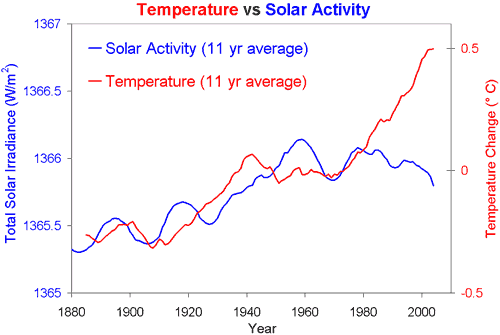Climategate 2.0 in Context - Solar Warming
Posted on 2 December 2011 by dana1981
One of the Climategate 2.0 emails highlighted by certain parties as "probably devastating" involved a query from Rob Wilson to Tim Osborn in 2005 regarding the solar contribution to relatively recent global warming. Here is the pertinant portion of Wilson's email, with the quote-mined portion highlighted in cherry red:
"I was always under the impression that, in general, solar changes controlled long term changes in climate and volcanic events caused short term cooling.
I am surprised when you say that volcanic forcing dominates the models - this seems at odds to papers by Lean and Rind etc."
{...}
"Although I agree that GHGs are important in the 19th/20th century (especially since the 1970s), if the weighting of solar forcing was stronger in the models, surely this would diminish the significance of GHGs.
Jeez - I sound like a sceptic - this is not my intension.
I guess, ultimately, what troubles me is that of the myriad of NH recons out there now, they generally show a MWP that is NOT as warm as the late 20th century. I have no trouble with this - however, the solar activity of the MWP (excluding the Oort minimum) is also generally not as high as the recent period. I know correlation does not mean causation, but it seems to me that by weighting the solar irradiance more strongly in the models, then much of the 19th to mid 20th century warming can be explained from the sun alone.
again, am I being overtly simplistic?"
Clearly Wilson is simply inquiring as to the role solar irradiance in the recent global warming. Note in particular the timeframe he discusses towards the end of the email - the 19th to mid-20th Century. In fact, as we have previously discussed, solar irradiance did play a significant role in the early 20th Century warming.
In order to determine the solar contribution, we have to start with the solar radiative forcing, which is the change in total solar irradiance (TSI) in Watts per square meter (W/m2) divided by 4 to account for spherical geometry, and multiplied by 0.7 to account for planetary albedo (Meehl 2002). The albedo factor is due to the fact that the planet reflects approximately 30% of the incoming solar radiation. As with CO2, we calculate the equilibrium temperature change by multiplying the change in radiative forcing by the climate sensitivity parameter (λ). This is a question of physics, not model weighting:
Solar irradiance hasn't increased by more than 1 to 2 W/m2 over the past 150 years. Therefore, the global warming due to solar irradiance over that timeframe is approximately 0.15 to 0.3°C (compared to 0.8°C observed surface warming).
Certainly if we artificially weighted solar irradiance more strongly in the models, it could explain more of the early 20th Century warming (although for this exercise to be scientifically valid, we would have to come up with a physical justification for this larger solar weighting). However, this would not change the human contribution to the global warming over the past 60 years, during which time solar irradiance has actually decreased slightly (Figure 1).

Figure 1: Global temperature (red, NASA GISS) and Total solar irradiance (blue, 1880 to 1978 from Solanki, 1979 to 2009 from PMOD).
In a previous email in the chain, Osborn explained the physics:
"the 1700-present greenhouse gas forcing is more than double the 1700-present solar forcing and hence the warming trend over that period in the model is driven mainly by GHGs."
In a subsequent email, Osborn explained how the forcings are input into the model:
"The forcings for ECHO-G are selected in advance by (1) choosing the strength and time series of solar irradiance variability; (2) choosing the strength and time series of volcanic aerosol variability and converting this to a surrogate time series of solar irradiance reductions, which are then added to (1); and (3) choosing the time series of greenhouse gas concentrations.
Thus (1) and (2) prescribe the forcings to the model - there is no role for the model itself to determine the strength of those forcings."
The bottom line is that Wilson was not suggesting that solar activity is responsible for more warming than we think, or greenhouse gases less, but merely asking the question 'what if models weight solar irradiance more strongly?' because of the historical correlation between irradiance and temperature.
However, the amount of warming attributed to solar irradiance is based on physics. Moreover, since 1960, solar activity has declined slightly, while the average global surface temperature has increased by more than 0.5°C. And while we experienced an exceptionally long solar cycle minimum over the past several years, 2010 tied for the hottest year on record. Thus it's quite clear that recent global warming is not due to the Sun, and the stolen Climategate emails don't even suggest (let alone demonstrate) otherwise.































 Arguments
Arguments






























[dana1981] Thanks, I shouldn't have assumed. Text revised.
[DB] "Also that whatever the equilibrium energy level was 150 years ago, solar increase alone changed it."
Straw man. Multiple factors (forcings and feedbacks) account for the changes in global temperatures over that timeframe.
"Further still, we don't know albedo very well or how it varied in the past or how it varies from year to year."
More straw men. I suggest you research more, pontificate less.
"IPCC models, lacking anything else to go on"
IBID. The models you reference are global circulation models, not something concocted by the IPCC. Your statement reveals either a lack of knowledge about them or a willingness to deliberately impart false information.
"A regression to the mean may be more likely."
Unsupported speculation. You have a protracted history on this forum of making unsubstantiated allegations and falsehoods. Cease.
[DB] The paternity for that graphic is here.